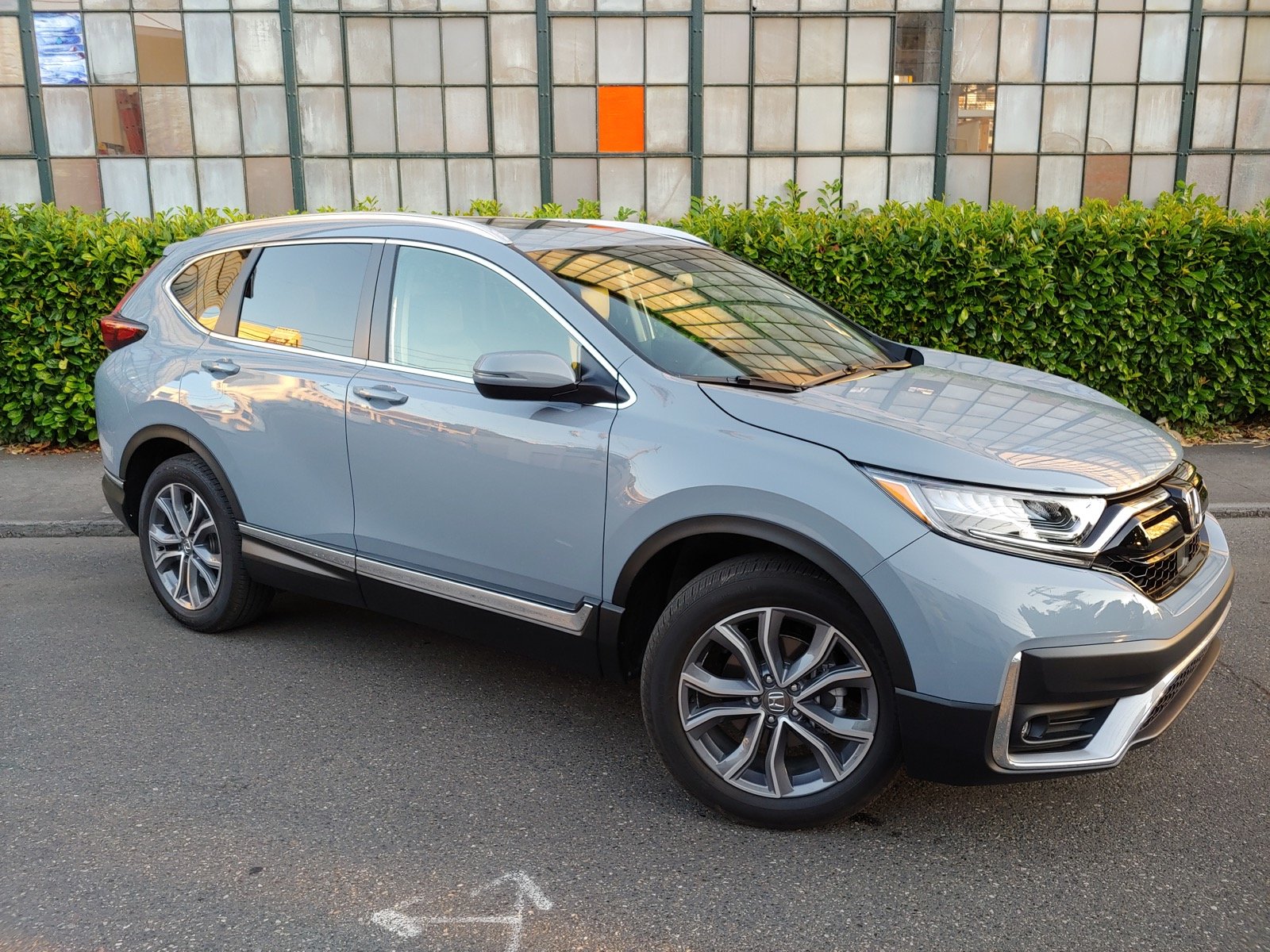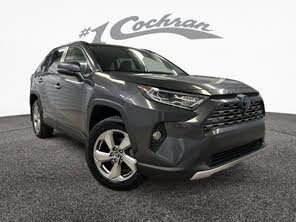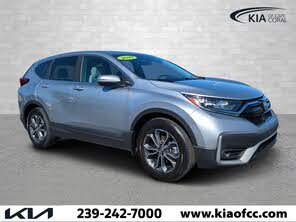2020 Toyota RAV4 Hybrid vs 2020 Honda CR-V
Overview | |
MSRP$25,150 | MSRP$28,350 |
Listings1506 | Listings578 |
Ratings & Reviews | |
User Reviews | User Reviews |
Expert reviews7.5 out of 10 | Expert reviews8.7 out of 10 |
Pros
Cons
| Pros
Cons
|
2020 Honda CR-V Reviews SummaryHonda’s compact SUV has been satisfying buyers for more than two decades, with more than five million CR-V’s sold. Such a legacy means the CR-V has long had its wrinkles smoothed out into a comfortable and capable crossover package that’s only downside may be its sheer inoffensiveness. This year’s model gets engine and safety upgrades, which improve fuel economy and help to make Honda’s bestseller an even better value. | |
2020 Toyota RAV4 Hybrid Reviews SummaryThe RAV4 Hybrid offers a nearly perfect package of compact crossover attributes: Standard all-wheel drive, a roomy passenger compartment, and excellent fuel economy. It’s a pretty good value, too, with pricing starting at $29,470, which includes plenty of standard multimedia and safety features. It’s no wonder sales of the hybrid version of Toyota’s bestseller almost doubled in 2019. | |
No video found | No video found |
Popular Features & Specs | |
Engine1.5L 190 hp I4 | Engine2.5L 219 hp I4 Hybrid |
Drive TrainFWD | Drive TrainAWD |
Seating Capacity5 | Seating Capacity5 |
Horsepower190 hp @ 5600 rpm | Horsepower |
EV Battery Capacity | EV Battery Capacity1.6 kWh |
MPG City28 | MPG City41 |
MPG Highway34 | MPG Highway38 |
Engine | |
Engine Name1.5L 190 hp I4 | Engine Name2.5L 219 hp I4 Hybrid |
Torque179 lb-ft @ 2000 rpm | Torque |
Horsepower190 hp @ 5600 rpm | Horsepower |
DrivetrainFWD | DrivetrainAWD |
Fuel Economy | |
EV Battery Capacity | EV Battery Capacity1.6 kWh |
MPG City28 | MPG City41 |
MPG Highway34 | MPG Highway38 |
Interior | |
Seating Capacity5 | Seating Capacity5 |
Safety | |
Front Crash Overall5 | Front Crash Overall4 |
Side Crash Overall5 | Side Crash Overall5 |
Dimensions & Capacity | |
Cargo Space39.2 cu ft | Cargo Space37.6 cu ft |
Curb Weight3337 lbs | Curb Weight3710 lbs |
Height66.1 in | Height67.0 in |
Length182.1 in | Length180.9 in |
Width73.0 in | Width73.0 in |
Wheelbase104.8 in | Wheelbase105.9 in |
Maximum Payload1358 lbs | Maximum Payload1210 lbs |
Number of doors4 | Number of doors4 |
Maximum Towing Capacity1500 lbs | Maximum Towing Capacity1750 lbs |
Overview | ||
MSRP | $25,150 | $28,350 |
Listings | ||
Ratings & Reviews | ||
User reviews | ||
Expert reviews | 7.5 out of 10Read full review | 8.7 out of 10Read full review |
Pros & cons | Pros
Cons
| Pros
Cons
|
Summary | Honda’s compact SUV has been satisfying buyers for more than two decades, with more than five million CR-V’s sold. Such a legacy means the CR-V has long had its wrinkles smoothed out into a comfortable and capable crossover package that’s only downside may be its sheer inoffensiveness. This year’s model gets engine and safety upgrades, which improve fuel economy and help to make Honda’s bestseller an even better value. | The RAV4 Hybrid offers a nearly perfect package of compact crossover attributes: Standard all-wheel drive, a roomy passenger compartment, and excellent fuel economy. It’s a pretty good value, too, with pricing starting at $29,470, which includes plenty of standard multimedia and safety features. It’s no wonder sales of the hybrid version of Toyota’s bestseller almost doubled in 2019. |
Video | No video found | No video found |
Popular Features & Specs | ||
Engine | 1.5L 190 hp I4 | 2.5L 219 hp I4 Hybrid |
Drive Train | FWD | AWD |
Seating Capacity | 5 | 5 |
Horsepower | 190 hp @ 5600 rpm | |
EV Battery Capacity | 1.6 kWh | |
MPG City | 28 | 41 |
MPG Highway | 34 | 38 |
Engine | ||
Engine Name | 1.5L 190 hp I4 | 2.5L 219 hp I4 Hybrid |
Torque | 179 lb-ft @ 2000 rpm | |
Horsepower | 190 hp @ 5600 rpm | |
Drivetrain | FWD | AWD |
Fuel Economy | ||
EV Battery Capacity | 1.6 kWh | |
MPG City | 28 | 41 |
MPG Highway | 34 | 38 |
Interior | ||
Seating Capacity | 5 | 5 |
Safety | ||
Front Crash Overall | 5 | 4 |
Side Crash Overall | 5 | 5 |
Dimensions & Capacity | ||
Cargo Space | 39.2 cu ft | 37.6 cu ft |
Curb Weight | 3337 lbs | 3710 lbs |
Height | 66.1 in | 67.0 in |
Length | 182.1 in | 180.9 in |
Width | 73.0 in | 73.0 in |
Wheelbase | 104.8 in | 105.9 in |
Maximum Payload | 1358 lbs | 1210 lbs |
Number of doors | 4 | 4 |
Maximum Towing Capacity | 1500 lbs | 1750 lbs |
The 2020 Honda CR-V was a familiar sight on the roads, thanks to its continued soft design approach, which had been in place since the 2017 model year. With its curvy and car-like lines, the CR-V’s exterior exuded a family resemblance to Honda’s sedan lineup. It leaned more towards a station wagon look rather than an assertive SUV, making it a practical choice for family transportation. However, the interior design was a different story. The CR-V’s cabin featured a mix of textures and materials, which sometimes looked out of place together. For instance, the top trims boasted upscale touches like wood-look trim and leather upholstery that clashed with some of the lower-quality plastics.
The CR-V offered four trim levels: LX, EX, EX-L, and Touring, with a base price starting at $26,270. All-wheel drive (AWD) was an available option for an additional $1,500 on all trims. The base models came with 17-inch alloy wheels, mid-level trims sported 18-inch wheels, while the Touring trim had 19-inchers. Although the CR-V included practical features like a retractable moonroof and roof rails in its top trim, it lacked the panoramic sunroof seen in competitors like the Toyota RAV4.
In contrast, the 2020 Toyota RAV4 Hybrid, redesigned in 2019, adopted a tougher, more angular look reminiscent of Toyota’s 4Runner. The front fascia featured trapezoidal apertures and a perforated grille, giving it a rugged and mechanical appearance complemented by dark trim around the wheel wells and doorsills. The RAV4 Hybrid looked ready for adventure, promising off-road capabilities.
The RAV4 Hybrid was available in four trims: LE, XLE, XSE, and Limited, with lower trims featuring 17-inch wheels and higher trims fitted with 18-inch wheels. Standard LED headlights and taillights provided great visibility, though only the top trims offered adaptive headlights. Inside, the RAV4 Hybrid had a simple and functional design with tastefully applied shiny bits of trim. While it did not offer leather upholstery (Softex was the available option), its interiors were comfortable and uniformly nice.


















For the 2020 Honda CR-V, the lineup featured a 1.5-liter turbocharged four-cylinder engine across all trims, which replaced the previous base 2.4-liter engine. This turbocharged engine delivered 190 horsepower and 179 pound-feet of torque, paired with a continuously variable automatic transmission (CVT). The powertrain provided a responsive and quick driving experience, especially in Sport mode. The CR-V’s car-like demeanor was evident in its superb road manners, with nicely weighted steering and nimble handling. It offered a firm yet comfortable ride with minimal body roll, and its low curb weight of 3,337 pounds for the FWD LX model contributed positively to acceleration, handling, and fuel economy.
EPA ratings were impressive, with 30 mpg combined for FWD models and 29 mpg for AWD models. These figures placed the CR-V among the top in its class, surpassing the Toyota RAV4 by 1 mpg in AWD form. Honda also introduced a hybrid version in 2020 to further appeal to those prioritizing fuel efficiency.
The 2020 Toyota RAV4 Hybrid, with its combined 219 horsepower, performed admirably in fuel economy, achieving an EPA rating of 40 mpg combined. It consistently met this figure in various driving conditions. The hybrid powertrain, consisting of a 2.5-liter gasoline engine paired with two electric motors, provided robust and swift acceleration. The innovative setup eliminated the need for a heavy driveshaft, resulting in a mere 200-pound weight increase over the non-hybrid model. The hybrid system distributed power efficiently, enhancing handling and fuel economy.
In practical terms, the hybrid system allowed the RAV4 Hybrid to accelerate quickly, with seamless regenerative braking and electric motor assistance. Additionally, it had a towing capacity of up to 1,750 pounds, equipped with trailer sway control for added safety.
Honda's mastery in packaging was evident in the 2020 CR-V's interior. It boasted spaciousness comparable to the class giant, the Volkswagen Tiguan, without feeling oversized. The seating offered excellent head and legroom, and the driver’s seat benefited from an ideal seating position for great front visibility. The cargo compartment was equally roomy, with a smart two-position load floor allowing for either maximum cargo space or a flat floor with the rear seats folded down, resulting in 75.8 cubic feet of cargo space. Clever storage solutions, like the deep well center console and expansive door pockets, made the CR-V very practical for daily use.
On the other hand, the 2020 Toyota RAV4 Hybrid provided excellent ergonomics with a well-thought-out interior layout. The standard 7-inch touchscreen (optional 8-inch screen) was conveniently positioned for easy access, accompanied by hard buttons and knobs for volume and tuning. The center console featured ample space for storing essentials, with an optional Qi wireless charging tray available.
The RAV4 Hybrid's interior could have been quieter, though the hybrid setup did lessen engine noise compared to the non-hybrid variant. Rear seating was particularly spacious, with impressive legroom, making it comfortable for three adults. Importantly, the hybrid components did not compromise interior or cargo space, which remained the same at 98.9 cubic feet of passenger volume and 37.6 cubic feet of cargo capacity, ample for the class.
The 2020 Honda CR-V's infotainment system showed its age, particularly in the base LX trim, which featured a subpar 5-inch screen offering limited functionality beyond Bluetooth connectivity and Pandora compatibility. Higher trims came with a 7-inch touchscreen, which was still relatively small compared to competitors. The user interface was cumbersome and lacked hard buttons, making it less intuitive to operate. Apple CarPlay and Android Auto were available only on the larger screen, and the system’s built-in navigation was limited to the Touring trim. However, the CR-V did offer plenty of USB ports in the EX trim and higher, with two in the front and two in the backseat, and introduced a wireless phone charger in the Touring trim for 2020.
The 2020 Toyota RAV4 Hybrid, for the first time, offered Android Auto, joining Apple CarPlay as standard features across all trims. Additionally, all trims came with SiriusXM Radio and a 3-month free trial. These smartphone integration features significantly enhanced the infotainment experience, outperforming Toyota’s proprietary Entune system. Navigation was offered with the premium JBL stereo, though most users preferred smartphone apps for direction. The RAV4 Hybrid also featured WiFi Connect with a 3-month, 2GB trial.
The RAV4 Hybrid had an advantage in technological offerings like Predictive Efficient Drive, which used various data sources to optimize battery use, thereby enhancing hybrid efficiency. Its drive mode selector allowed drivers to choose between Eco, Sport, and Trail settings, adjusting the vehicle's responsiveness and efficiency accordingly.
The 2020 Honda CR-V came standard with the Honda Sensing suite, which included forward-collision warning with automatic emergency braking, pedestrian detection, road-departure mitigation, adaptive cruise control, and lane-keeping assist. Additional safety features like blind-spot monitoring and cross-traffic monitoring were available on the EX trim and above. The CR-V earned high safety ratings from the NHTSA with a five-star overall rating and a Top Safety Pick designation from the IIHS, though lower trims scored marginal in headlight performance.
The 2020 Toyota RAV4 Hybrid was equipped with Toyota Safety Sense 2.0, offering similar features such as pre-collision system with automatic emergency braking, pedestrian detection, dynamic radar adaptive cruise control, lane departure alert with steering assist, automatic high beams, and road sign assist. Blind spot monitoring and parking assist were optional. The RAV4 Hybrid received a five-star rating from the NHTSA but had two safety recalls for engine coolant leaks and suspension issues.
CarGurus highlights

According to CarGurus experts, the overall rating for the 2020 Honda CR-V was 7.5 out of 10, while the 2020 Toyota RAV4 Hybrid scored 8.7 out of 10. Given these ratings, consumers looking for better fuel efficiency, advanced technology, and a rugged design should choose the 2020 Toyota RAV4 Hybrid. It offers exceptional performance, a high level of standard features, and economical driving, making it the clear winner in this comparison.
Choose the 2020 Toyota RAV4 Hybrid if:
- You seek superior fuel economy with a combined rating of 40 mpg and an innovative hybrid system.
- You want a rugged and adventurous exterior design with off-road capability.
- You prefer advanced technology and seamless smartphone integration with standard Android Auto and Apple CarPlay.
Choose the 2020 Honda CR-V if:
- You prioritize a well-packaged and spacious interior with clever storage solutions.
- You value lower fuel consumption for AWD models and a more sedan-like driving experience.
- You want a vehicle with a reputation for good road manners and nimble handling.
CarGurus highlights

According to CarGurus experts, the overall rating for the 2020 Honda CR-V was 7.5 out of 10, while the 2020 Toyota RAV4 Hybrid scored 8.7 out of 10. Given these ratings, consumers looking for better fuel efficiency, advanced technology, and a rugged design should choose the 2020 Toyota RAV4 Hybrid. It offers exceptional performance, a high level of standard features, and economical driving, making it the clear winner in this comparison.
Choose the 2020 Toyota RAV4 Hybrid if:
Shop Now- You seek superior fuel economy with a combined rating of 40 mpg and an innovative hybrid system.
- You want a rugged and adventurous exterior design with off-road capability.
- You prefer advanced technology and seamless smartphone integration with standard Android Auto and Apple CarPlay.
Choose the 2020 Honda CR-V if:
Shop Now- You prioritize a well-packaged and spacious interior with clever storage solutions.
- You value lower fuel consumption for AWD models and a more sedan-like driving experience.
- You want a vehicle with a reputation for good road manners and nimble handling.

By: CarGurus + AI
At CarGurus, our team of experienced automotive writers remain at the heart of our content operation, conducting hands-on car tests and writing insightful guides that are backed by years of industry experience. To complement this, we are harnessing AI to make our content offering more diverse and more helpful to shoppers than ever. To achieve this, our AI systems are based exclusively on CarGurus content, ratings and data, so that what we produce is both unique to CarGurus, and uniquely helpful to car shoppers.






































